-
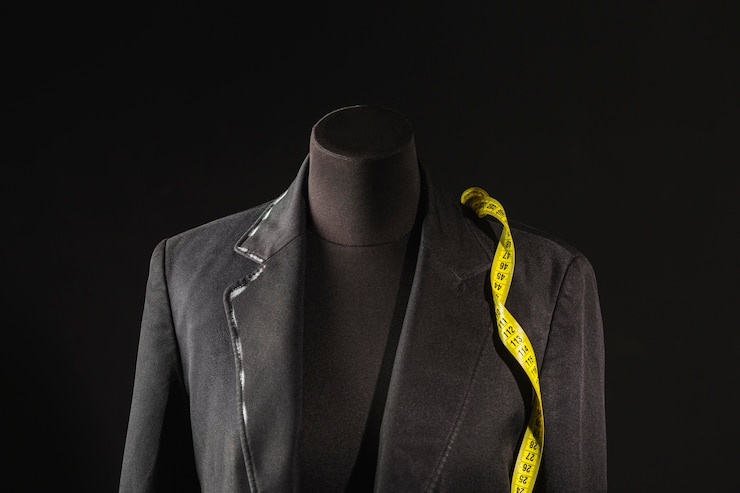 What is Bespoke Clothing? Your Ultimate Guide
What is Bespoke Clothing? Your Ultimate GuideBespoke clothing is custom-made apparel crafted through bespoke tailoring, designed to an individual’s exact measurements and style preferences, offering unmatched fit and personalization. Unlike ready-to-wear or made-to-measure, bespoke involves creating a unique pattern for each client, ensuring a one-of-a-kind garment.
Why Bespoke Clothing Stands Out
Bespoke clothing matters because it solves common fashion frustrations: ill-fitting clothes, generic designs, and low-quality materials. For those with non-standard body types (e.g., tall, petite, or plus-size), bespoke ensures a flattering fit that off-the-rack clothing rarely delivers. It’s also a sustainable choice, as high-quality garments last decades, reducing the need for frequent replacements.
Beyond practicality, bespoke fashion offers a unique experience. Collaborating with a tailor to design a suit, dress, or even a custom shirt lets you express your individuality, making it ideal for weddings, career-defining moments, or simply elevating your everyday style. In a world of fast fashion, bespoke’s craftsmanship and exclusivity appeal to those who value authenticity and long-term value.
How Bespoke Clothing Is Made
Bespoke clothing is crafted like a unique work of art, tailored exclusively for you. The process begins with a consultation, where a skilled tailor takes dozens of precise measurements and explores your vision—perhaps a bold fabric or a timeless cut. A one-of-a-kind pattern is hand-drawn, and the garment is meticulously cut and sewn using premium materials, such as fine wool or soft linen. Typically, the creation takes 8-12 weeks, during which you’ll attend 2-3 fittings to ensure perfection. At these fittings, any imperfections are carefully refined. Artisans invest extra effort in details like collars or cuffs, a labor-intensive process that captures the charm of bespoke clothing—resulting in a garment that perfectly reflects your style and brings your ideas to life. Ultimately, you receive a truly one-of-a-kind piece, unmatched anywhere else.
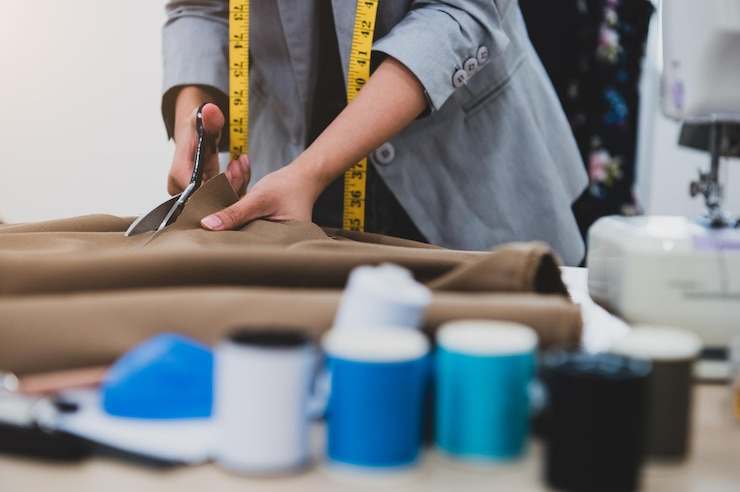
Key Benefits of Bespoke Clothing
Flawless Fit
Bespoke is made for your body, fixing issues like loose shirts or tight skirts. Picture a suit that feels as comfortable as your favorite sneakers, tailored to your exact shape.
Personal Style
You’re in charge—choose fabrics, patterns, or even a special detail, like a coat with a lining inspired by a cherished memory.
Exceptional Durability
Crafted with top-quality materials and meticulous techniques, bespoke lasts for years. For example, a high-quality custom-made dress will remain bright and intact even after being worn countless times.
Bespoke vs. Made-to-Measure vs. Off-the-Rack
· Off-the-Rack: Mass-produced clothes from stores are affordable but often fit poorly, especially for unique body types, and use materials that fade or tear quickly.
· Made-to-Measure: Adjusts a pre-existing pattern to your measurements, with some machine sewing, offering a better fit than off-the-rack but less customization.
· Bespoke: Creates a brand-new pattern with extensive handwork, giving you endless design options and a fit that’s unmatched, though it takes more time.
How to Start Your Bespoke Journey
1. Find a Tailor: Look for experts in bespoke tailoring with excellent reviews and portfolios showcasing diverse styles. Visit their studio to see their craftsmanship, like hand-stitched seams or custom designs.
2. Plan Your Budget: Discuss pricing with tailors to understand costs based on fabric and complexity. Start with a versatile piece, like a tailored blazer, for maximum wear.
3. Book a Consultation: Share your goals (e.g., a wedding suit, everyday dress) and bring inspiration, like photos or sketches. Ask about fabric options and care.
4. Allow Time: Expect 8-12 weeks, including fittings. Plan ahead for events like galas or interviews.
5. Verify Quality: Choose tailors with industry recognition or strong client testimonials to ensure top-notch work.
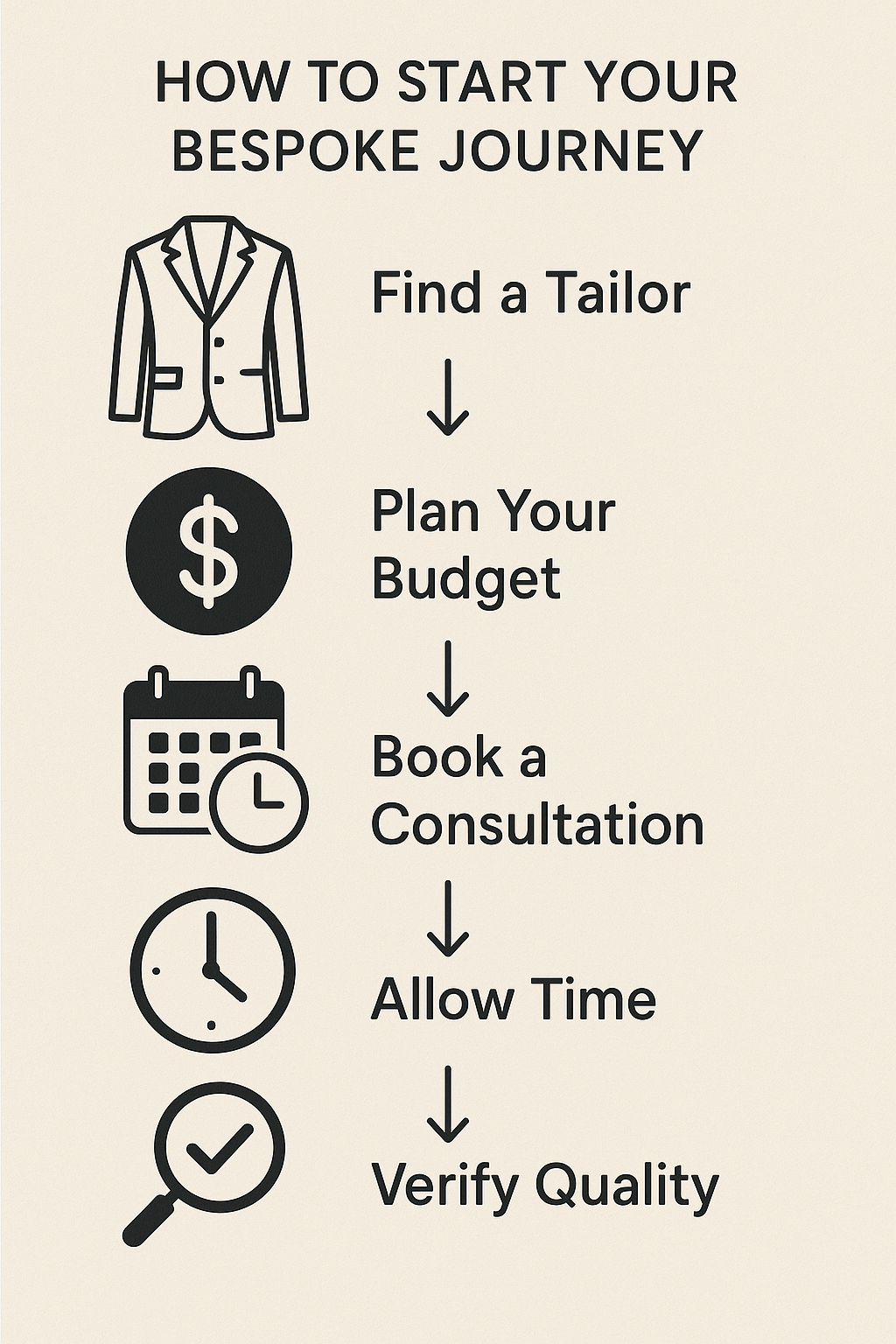
How Much Does Bespoke Clothing Cost?
The cost of bespoke clothing varies depending on the tailor, fabric, and design details, making it hard to pin down a universal price. To get accurate pricing, contact reputable tailors directly for quotes—many offer free consultations or pricing guides on their websites. You can also explore online bespoke platforms, like those specializing in suits or dresses, which often list starting prices or customization options. Comparing quotes from multiple tailors and asking about fabric choices (e.g., cotton vs. luxury wool) will help you find a price that fits your budget.
Can Bespoke Be Casual or for Women?
Yes, bespoke fashion goes far beyond custom formal suits. Tailors craft women’s pieces, from elegant gowns to tailored trousers, with designers showcasing bespoke’s versatility. Casual bespoke, such as custom casual wear like custom jeans or relaxed jackets, is also popular for everyday style.
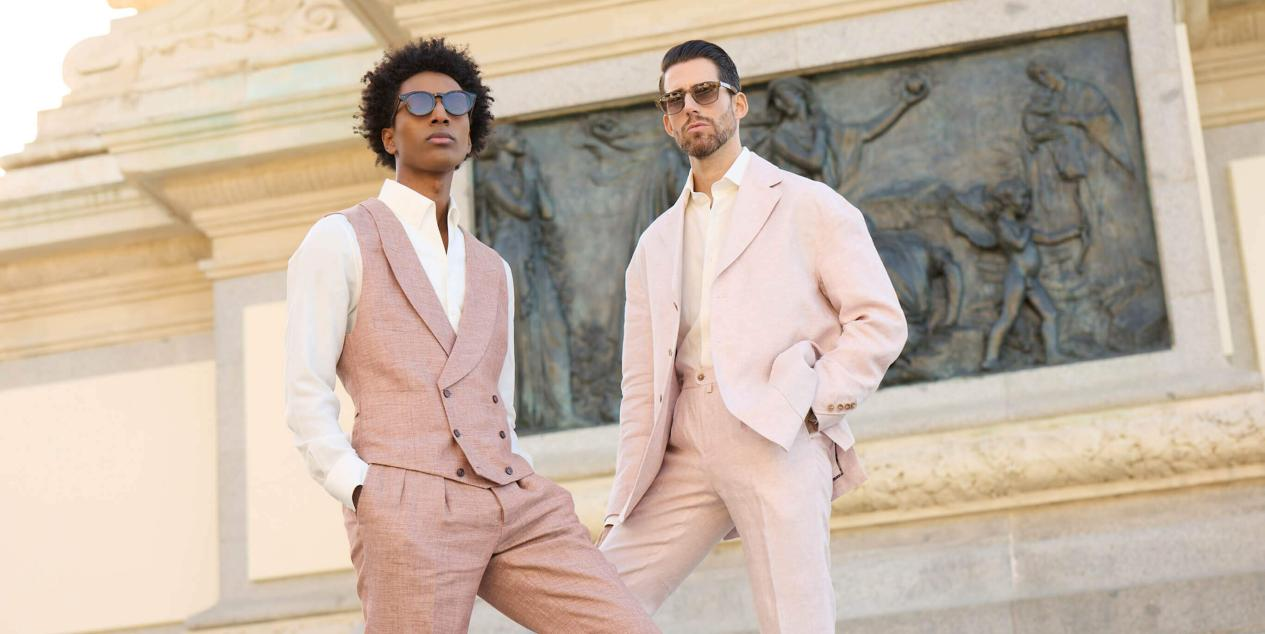
Is Bespoke Clothing Sustainable?
Absolutely—bespoke clothing is eco-friendly because its durable designs last decades, reducing the need for frequent replacements. Many tailors use sustainable fabrics, like organic cotton or ethically sourced silk, helping you build a wardrobe that’s kind to the planet.
How Do I Choose a Reliable Tailor?
Select a tailor with a solid reputation, backed by online reviews and a portfolio of custom work. Visit their workshop to check for quality details, like hand-stitched linings or precise cuts. Ask about their experience, fitting process, and any industry endorsements, such as affiliations with tailoring guilds. Avoid tailors who rush or offer limited design choices.
Final Thoughts
Bespoke clothing offers a perfect fit, personal creativity, and sustainable quality, making it a transformative choice for anyone tired of ordinary fashion. Whether it’s a suit that boosts your confidence or a dress that feels like you, bespoke lets you wear your story. Reach out to a trusted tailor or browse online options to start creating a wardrobe that’s uniquely yours.
MORE 2025-05-30 -
 How to Start an Online Clothing Business: A Step-by-Step Guide
How to Start an Online Clothing Business: A Step-by-Step GuideThinking about starting your own clothing brand online but not sure where to begin? You’re not alone. Thousands of aspiring entrepreneurs search for how to start an online clothing business every month—looking for practical, no-fluff guidance on turning their fashion ideas into reality.
Whether you're dreaming of launching a made-to-measure label, building a sustainable fashion brand, or setting up a print-on-demand store from your bedroom, this step-by-step guide covers everything you need.
1. Define Your Niche and Target Audience
In the saturated world of online fashion, finding your niche isn’t just helpful—it’s essential. A niche helps you attract the right audience, position your brand effectively, and build long-term loyalty.
Examples of strong niches include:
Sustainable fashion made from organic fabrics
Plus-size streetwear with bold prints
Made-to-measure (MTM) suits for professionals
Activewear for women over 40
Once you’ve selected a niche, dig deeper into your target audience:
What are their style preferences?
Where do they shop online?
What problems are they trying to solve with their wardrobe?
Create a customer persona—a fictional profile of your ideal buyer—to guide every decision from product design to marketing.
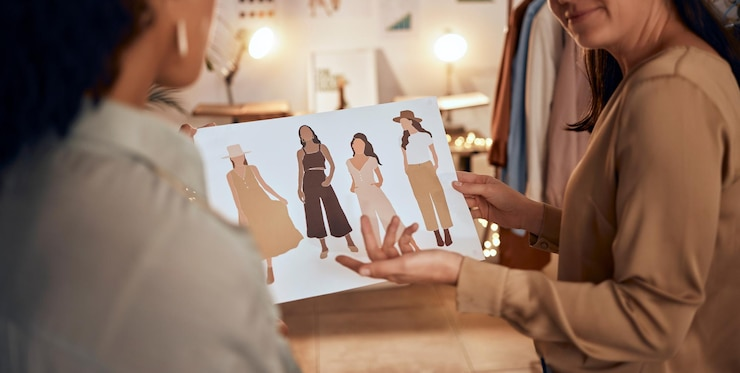
2. Create a Clothing Business Plan
A business plan isn’t just for investors—it’s your roadmap. It helps you clarify your vision and stay focused when challenges arise.
Your plan should include:
Business model: Will you sell inventory you stock yourself? Use a dropshipping model? Or offer print-on-demand or MTM customization?
Startup costs: Factor in website setup, product samples, packaging, branding, and initial marketing.
Revenue goals: Set milestones for your first 3, 6, and 12 months.
Operations strategy: Will you fulfill orders in-house, or partner with a logistics provider?
Marketing plan: Identify key channels (e.g., social media, email, influencers) and how you’ll use them to attract customers.
This is also the time to consider your legal and financial foundations—register your business, open a separate bank account, and explore basic accounting tools.
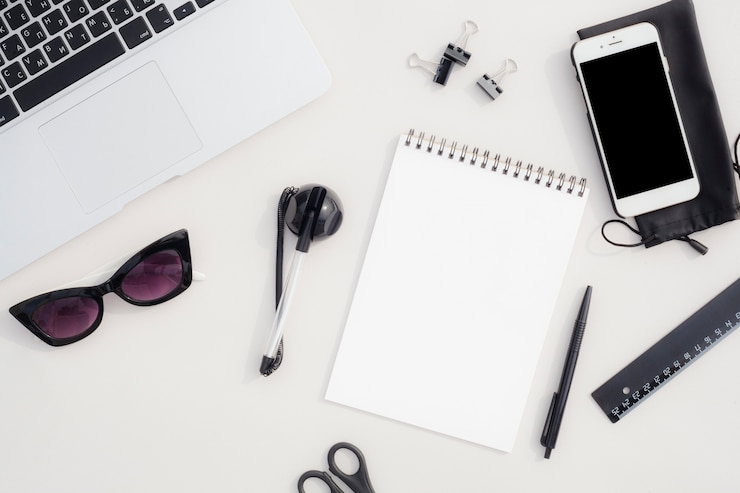
3. Choose the Right E-commerce Platform
Your e-commerce platform is the foundation of your online store—it should match your business model, be easy to manage, and allow for future growth.
Popular platforms include:
Shopify: User-friendly, scalable, and full of features for ready-to-wear and dropshipping brands.
WooCommerce: A flexible, open-source option for WordPress users with more technical control.
BigCommerce: Known for built-in features and scalability.
Printful / Printify: Great for print-on-demand apparel with design and fulfillment integration.
For custom or made-to-measure (MTM) businesses, platforms like Kutetailor are purpose-built. Kutetailor offers a backend system for tailors, retailers, and designers to manage custom orders, product uploads, and customer measurements. Unlike general platforms, it supports the full MTM workflow—from order entry to production tracking—making it ideal for bespoke apparel brands.
When choosing a platform, consider:
Ease of use for non-developers
SEO and mobile optimization
Payment gateways and shipping options
Integration with tools like email marketing or inventory systems

4. Source or Produce Your Products
Once you’ve decided what kind of clothing you want to sell, you’ll need to figure out how to get it.
You have three main options:
Buy wholesale from established suppliers and resell under your own brand.
Manufacture your own designs, either locally or overseas.
Use on-demand or made-to-measure (MTM) services to customize each product per customer order.
Whichever you choose, always:
Order product samples to evaluate quality firsthand.
Understand lead times and minimum order quantities (MOQs).
Clarify return, defect, and restocking policies before committing.

If you're going the custom route, be sure to research and partner with custom apparel suppliers that align with your quality standards and delivery timelines.
5. Build a Unique and Consistent Brand
Your brand is what sets you apart—and it's more than a logo.
Start by defining:
Your brand name and tagline: Memorable and relevant to your audience.
Visual identity: Colors, typography, and imagery that reflect your values.
Voice and tone: Are you playful, minimalist, premium, street-smart?
Make sure your branding is consistent across your website, product packaging, email marketing, and social media channels. The goal is to create a professional and cohesive experience that builds trust with your audience from the first impression.
6. Set Up Your Clothing Online Store
Now it’s time to build your storefront. This is where your customers will browse, fall in love with your products, and hit “buy now.”
A good online store should have:
Clean, intuitive navigation
High-resolution product images and size charts
Persuasive product descriptions
Mobile optimization
Secure checkout and payment processing
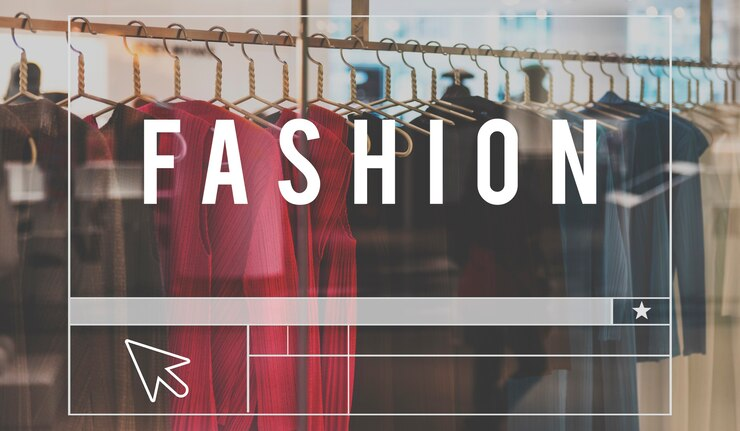
For MTM brands, Kutetailor offers a complete online platform tailored for the custom clothing business. Whether you're just starting or already offering made to measure clothing online, Kutetailor provides the infrastructure you need to simplify operations and scale efficiently.
Key features include:20+ website templates for fast, attractive store setup
Visual Order Center: Easily configure suits, shirts, or accessories without any coding
Live order tracking, fabric inventory sync, and real-time updates
Marketing Center: Built-in email and social media tools to automate promotions
Data dashboard for sales analysis and customer behavior insights
With Kutetailor, tailors, designers, and MTM retailers can manage their digital storefront and backend production from one seamless platform.7. Promote Your Brand Online
You’ve built a store—now it’s time to bring in traffic.
Your marketing plan should include a mix of:
Social Media: Platforms like Instagram, TikTok, and Pinterest are ideal for fashion. Focus on high-quality visuals, trending audio, and storytelling.
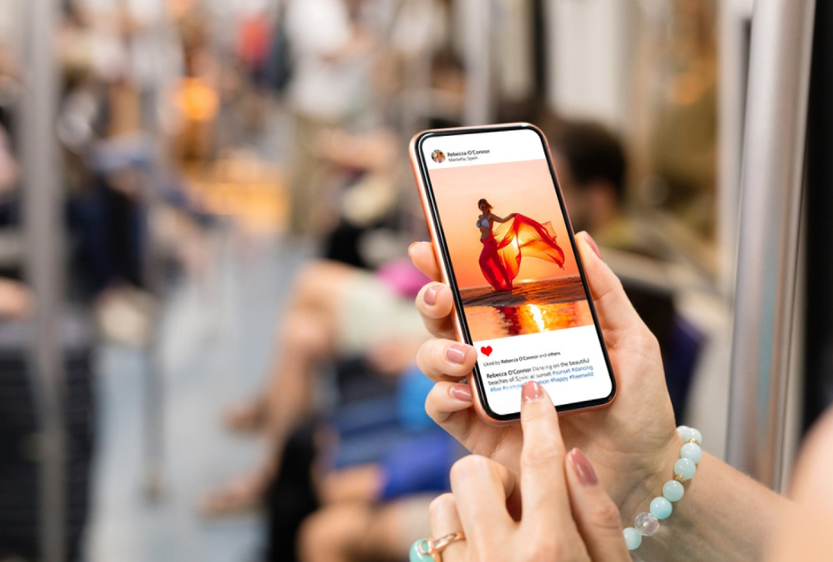
Influencer Collaborations: Work with micro-influencers or niche creators who align with your brand values.
Email Marketing: Set up automated welcome sequences, abandoned cart flows, and new arrival announcements.
Content Marketing: Write blog posts, film behind-the-scenes videos, or share styling tips to drive SEO traffic.
Paid Advertising: Use Facebook Ads or Google Shopping to target specific audiences based on interests and behavior.
Consistency and authenticity are key. Don’t just sell—engage.
8. Manage Logistics and Customer Service
Order fulfillment and support can make or break your brand.
Here’s how to stay on top of both:
1. Shipping: Choose a reliable carrier and be transparent about shipping times and fees.
2. Returns: Offer a clear and fair return policy. This builds customer trust and increases conversion.
3. Customer Support: Provide email or chat support with fast response times. Tools like Zendesk or Gorgias can help.
4. Inventory Management: Use tools to track low stock levels, restock popular items, and forecast demand.

★ If you’re using a fulfillment platform like Kutetailor, many of these processes can be streamlined into your backend workflow.
9. Track Performance and Optimize
You can’t grow what you don’t measure.
Monitor your store’s performance using:
Google Analytics: Track traffic, bounce rates, and user behavior.
Conversion Tracking: Identify which pages are converting—or not.
Email Metrics: Measure open and click rates.
Customer Feedback: Use surveys or reviews to discover what’s working (and what’s not).
Run A/B tests on product titles, images, or homepage layouts. Even small improvements can lead to big gains in revenue over time.
10. Plan for Growth
Once you’ve found traction, it’s time to scale up.
Here’s how:
Launch new products: Expand your collection or introduce limited-edition drops.
Enter new markets: Translate your site or offer international shipping.
Sell across channels: Consider marketplaces like Amazon, Etsy, or Zalando.
Collaborate: Co-brand with influencers or other fashion labels.
Go offline: Host pop-up shops or trunk shows to build community and collect feedback.
Above all, stay agile. The fashion industry moves fast, so continue innovating and listening to your audience.
Final Thoughts
Starting an online clothing business isn’t reserved for big budgets or tech experts. With the right tools, a clear strategy, and a strong brand identity, anyone can build a profitable store that reflects their vision and connects with real customers.
If you're in the custom or made-to-measure space, platforms like Kutetailor offer everything you need to simplify production, launch your site, and grow fast—without needing to code or manage complex workflows.
Still wondering how to start an online clothing store that actually works? Start small. Pick your niche. Choose the right platform. Launch a product. You don’t need to get everything perfect—just get it moving.
Ready to turn your fashion idea into a brand?
Explore platforms, build your first product, and take that first real step today.MORE 2025-05-20 -
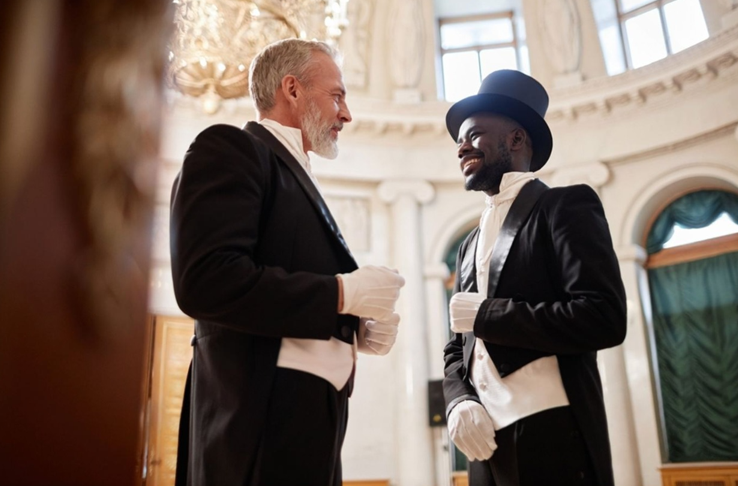 What Is a Tailcoat and How to Wear It
What Is a Tailcoat and How to Wear ItThe tailcoat, one of the most formal garments a man can wear. You may have encountered the term “tailcoat” on an invitation to a white tie event, sparking curiosity about this attire. In modern society, tailcoats are seldom seen, and their strict dress code is known to few, leaving many puzzled about their role in contemporary fashion.
What Is a Tailcoat?
A tailcoat, also known as a dress coat, tuxedo tail, or full dress tail, is a knee-length, double-breasted jacket with a cut-away front and long tails at the back, designed solely for the white tie dress code—the most formal evening attire for men. Made from black or midnight blue wool (often barathea or mohair), it boasts silk-faced peaked lapels, a single center vent, and three non-functional buttons on each side. The tails, reaching the back of the knees, form the iconic “swallow-tail” silhouette, while the snug, unbuttoned fit highlights the torso.
Distinct from the morning coat (used in daytime morning dress) or equestrian shadbelly, the evening tailcoat is a hallmark of prestige. It is widely regarded as the king of all men's clothing.

A Brief History of the Tailcoat
The tailcoat traces its roots to the late 18th century, evolving from riding coats with fronts cut for horseback ease. Fashion pioneer George Brummell championed it as formal daywear, but by the 1850s, it became exclusive to white tie eveningwear, supplanting frock coats for daytime formality. The tuxedo (black tie) overtook it in the early 20th century, relegating the tailcoat to the most exclusive evening occasions, with rare daytime exceptions like European diplomatic ceremonies.
Today, the tailcoat shines at high-profile galas and formal banquets, its scarcity enhancing its allure as a symbol of enduring elegance.
When to Wear a Tailcoat
The tailcoat is reserved for white tie events, held after 6 p.m. or sundown, as explicitly stated on invitations. These include:
· Grand balls, like those in historic European palaces.
· Formal state dinners or diplomatic receptions.
· Elite evening gatherings, such as cultural festivals or prestigious award ceremonies.
Daytime wear is rarely acceptable, permitted only when traveling to an evening event or for specific European state functions. The tailcoat is inappropriate for black tie, semi-formal, or casual settings like proms or office parties, where a tuxedo or suit is better suited.
Formality varies by region, with Europe upholding stricter white tie standards. In the U.S., formalwear is more flexible, but white tie remains a rare choice, making the tailcoat a striking statement.
How to Wear a Tailcoat – The White Tie Ensemble
Mastering the tailcoat requires precision, as the white tie ensemble is a harmonious blend of components. Here’s how to style it impeccably:
Core Components
· Jacket: A black or midnight blue tailcoat with silk-faced peaked lapels, tailored for a snug, unbuttoned fit. The tails should reach the back of the knees.
· Trousers: High-waisted, matching the jacket, with double-braided satin stripes for polish.
· Waistcoat: White piqué, single-breasted with a shawl collar, ending above the tailcoat’s front points for clean lines.
· Shirt: White with a stiff, detachable wing collar and bib front, fastened with two or three studs.
· Bow Tie: White piqué, self-tied to reflect authenticity.
Accessories
· Shoes: Patent leather opera pumps with grosgrain bows for tradition, or polished black oxfords for a modern touch.
· Socks: Long black silk socks for a seamless look.
· Optional: White gloves, a top hat, a white linen pocket square, a boutonnière, or a cane for historical flair.
Fit and Tailoring
A tailcoat demands custom formal wear or made-to-measure tailoring. The waistcoat and shirt must not extend below the tailcoat’s front, and the tails should align with the knees. A proper fit enhances posture and elegance.
Styling Tips
· Choose black for tradition or midnight blue for a rich, modern hue under evening light.
· Avoid notch lapels, common in low-quality rentals, and ensure the bow tie suits your face’s proportions.
· Add a monogrammed shirt for a personal touch, ideal for significant events like weddings.
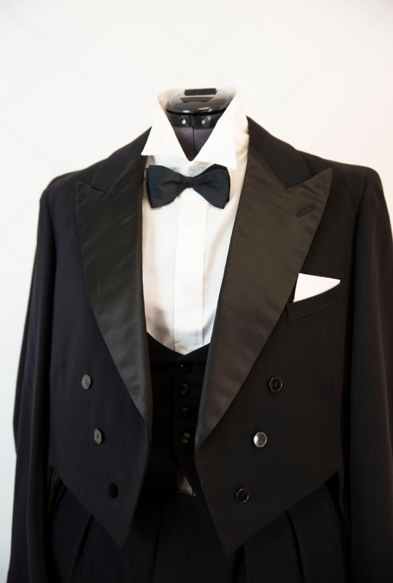
Can You Wear a Tailcoat to a Wedding?
A tailcoat is suitable for a wedding only if the invitation specifies “white tie” and the ceremony or reception starts after 6 p.m., marking an ultra-formal evening event. These are rare, often high-profile weddings. Grooms or groomsmen may don tailcoats to complement a grand bridal vision, perhaps with a boutonnière for distinction.
For most weddings, a tailcoat is out of place. Daytime weddings or those requesting black tie or suits call for a tuxedo or formal suit. In the UK, evening weddings are uncommon, making white tie even less likely. In the U.S., some daytime weddings may misuse tailcoats due to relaxed norms, but this strays from tradition—always confirm with the couple.
Etiquette and Tips
· Check the dress code: Consult the couple or planner to avoid overdressing, which could clash with the event’s tone.
· Guest vs. Groom: As a guest, ensure your tailcoat doesn’t overshadow the groom. As a groom, coordinate with the bridal party, perhaps matching the bride’s gown with white tie elegance.
· Renting: For a one-time event, rent from trusted services, ensuring a tailored fit to avoid a boxy appearance.
· Comfort: Practice moving in the tailcoat—sitting, standing, dancing—to feel confident during the ceremony and reception.
A tailcoat at a white tie wedding is a bold, elegant choice, but it requires careful adherence to the event’s formality.
What Is the Difference Between a Tailcoat and a Tuxedo?
The tailcoat (white tie) and tuxedo (black tie) are distinct formal eveningwear options, often confused due to their refined looks. Here’s how they differ:
Feature Tailcoat (White Tie) Tuxedo (Black Tie) Formality Highest level; for state dinners, grand balls Less formal; suitable for galas, proms, weddings Jacket Design Long tails, cut-away front, silk-faced peaked lapels Shorter length, satin lapels (peaked/shawl/notch) Accessories White piqué waistcoat, wing-collar shirt, white bow tie Black cummerbund/waistcoat, pleated shirt, black bow tie Shoes Patent leather opera pumps Patent leather oxfords or loafers Occasions Strictly white tie after 6 p.m., rare occasions Common for black tie or optional events, including some daytime ones Extra Items Optional: Top hat, white gloves Optional: Colored pocket square, modern cufflinks 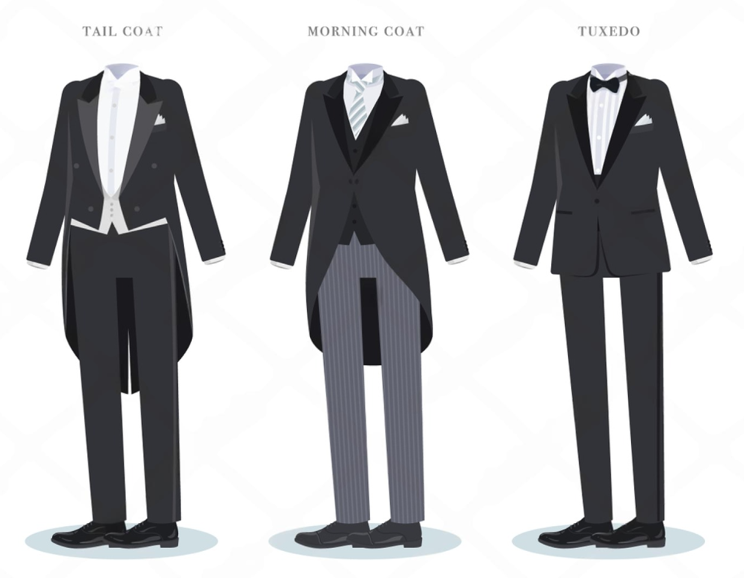
Check the invitation’s dress code to choose correctly. Tuxedos fit most modern formal events, while tailcoats shine in confirmed white tie settings.
Conclusion
The tailcoat is the epitome of men’s formalwear, perfect for white tie events like lavish evening weddings or grand balls, distinct from the more adaptable tuxedo. Its history, precise styling, and exclusivity make it a beacon of sophistication. Whether you’re stepping into a high-society wedding or a cultural gala, the tailcoat elevates any moment into timeless elegance. For broader formal occasions, a tuxedo may suffice, but the tailcoat awaits those ready to embrace tradition. If you’re sourcing high-end garments for clients or events, working with custom apparel suppliers ensures access to tailored pieces that meet white tie standards.
MORE 2025-05-17 -
 Satmar vs. Chabad Kapote: Understanding the Differences
Satmar vs. Chabad Kapote: Understanding the DifferencesThe kapote — the distinctive long black coat — is a central garment in Hasidic Jewish culture, worn by men as a symbol of modesty, tradition, and religious commitment. While many Hasidic groups share this traditional attire, the nuances between them are meaningful. In particular, Satmar and Chabad, two prominent Hasidic sects, exhibit notable differences in the style, use, and symbolism of their kapotes.
Historical and Cultural Context
Understanding the kapote begins with appreciating the distinct backgrounds of Satmar and Chabad.
Satmar, founded by Rabbi Joel Teitelbaum in Hungary, is known for its strict traditionalism and emphasis on community insularity. Preserving old-world customs is central to Satmar identity, and this conservatism is deeply reflected in their dress.Chabad-Lubavitch, originating in 18th-century Russia under Rabbi Schneur Zalman of Liadi, takes a more outward-facing approach. Chabad is deeply involved in outreach ("kiruv"), aiming to engage and inspire Jews around the world. Their attire, while traditional, often embodies a subtle balance between reverence for heritage and readiness to engage the modern world.
Thus, the philosophies of these groups naturally influence their approach to the kapote — how it is designed, when it is worn, and what it symbolizes.
Design and Tailoring Differences
While both Satmar and Chabad communities wear kapotes, their designs reflect different priorities and philosophies. The table below summarizes the key distinctions:
Feature Satmar Kapote Chabad Kapote Fabric and Texture High-quality silk or satin, formal sheen Durable wool or polyester blend, practical texture Cut and Fit Loose, flowing, modest emphasis More structured and fitted, balancing tradition and modernity Buttons and Embellishments Multiple rows of buttons, some subtle decorations Simple design, usually one row of buttons, minimalistic These differences, though subtle to an untrained eye, carry significant meaning within each community’s cultural and religious framework.
Occasions and Usage
Satmar Practices
For Satmar men, the kapote is predominantly worn during Shabbat, Jewish holidays, weddings, and significant religious events. It’s not typically daily wear. The donning of the kapote is an elevated act, signifying respect for sacred times.Chabad Practices
Chabad men, particularly rabbis and emissaries, often wear their kapote daily. Whether attending morning prayers, conducting Torah classes, or running community programs, the kapote serves as a symbol of their constant religious mission.
This daily usage also explains the preference for more durable fabrics and slightly more practical designs compared to the ceremonial richness of Satmar kapotes.
Symbolism, Identity, and Community Perceptions
Though the Satmar and Chabad kapotes appear outwardly similar, their symbolic meanings and community expectations differ profoundly.
For the Satmar community, the kapote represents a form of religious defense — a visible barrier against the secular world. It embodies separation, preserving purity by minimizing external influences. Wearing the kapote reinforces internal solidarity and a commitment to insularity, emphasizing community cohesion over engagement with broader society. Uniformity in dress is highly valued; small variations are discouraged to maintain a strong, collective identity.
In contrast, for Chabad, the kapote serves as a symbol of religious mission and outreach. It is not just about preserving personal piety but about actively engaging others. A Chabad emissary wearing a kapote is a living ambassador of Jewish tradition, ready to teach and inspire wherever he goes.
While Chabad maintains a traditional dress code, there is slightly more room for personal adaptation — tailoring choices, material preferences, and climate adjustments — so long as the core standards of dignity and modesty are preserved.
This flexibility reflects Chabad's broader openness to engaging diverse environments without compromising fundamental values.In essence, while both kapotes signify devotion, Satmar’s version leans inward toward protection and uniformity, whereas Chabad’s leans outward toward mission and adaptability.

Custom Kapota Tailoring
For those seeking garments that align precisely with their community's traditions and personal requirements, custom kapote tailoring is an ideal solution. Whether following Satmar’s ceremonial design or Chabad’s practical daily style, custom tailoring ensures the kapote fits appropriately, uses suitable materials, and reflects the intended cultural symbolism.
If you want to make custom kapotas in bulk, look for experienced custom apparel suppliers to make them.
Conclusion
The kapote stands as a powerful symbol in both Satmar and Chabad communities — a garment woven with threads of faith, history, and philosophy. Yet the differences in fabric, fit, frequency of use, and meaning reflect the unique journeys of each group.
Understanding these distinctions offers more than just a lesson in Hasidic fashion — it opens a window into how clothing can mirror the deepest values and missions of a community. Whether flowing silk or tailored wool, each kapote tells a story of devotion, identity, and purpose.
MORE 2025-05-17 -
 Avoid Making this 8 Mistakes When Starting a Clothing Brand
Avoid Making this 8 Mistakes When Starting a Clothing BrandThe global fashion industry, valued at over $3 trillion, is a tantalizing space for creative entrepreneurs dreaming of launching their own clothing brands. Yet, the road to success is fraught with challenges, with many startups failing within their first few years. While passion and creativity are essential, avoiding critical mistakes is equally important. From neglecting brand identity to mismanaging finances, new designers often fall into preventable traps. This article outlines the key pitfalls to steer clear of when starting your clothing brand, empowering you to build a sustainable and distinctive business.
Failing to Define a Unique Brand Identity
One of the biggest mistakes new designers make is launching without a clear brand identity. A vague or generic vision leaves your brand lost in a sea of competitors. Failing to define your niche and target audience can result in products that lack direction. Brands without a compelling story struggle to build customer loyalty.
Imagine launching a line of athleisure wear that mimics popular brands like Lululemon without a unique angle—customers have no reason to choose you. A strong brand identity, rooted in a clear mission and aesthetic, sets you apart.
Solution:
1. Write a Brand Mission Statement: Move beyond a simple mission statement to create a brand narrative using the “3C model” (Customer, Culture, Cause). Define your customer’s core needs, align with cultural trends, and champion a cause. For example, Patagonia’s “fight for the planet” narrative drives its eco-focused designs.
2. Define Your Audience: Create a buyer persona with details like age, income, and style preferences (e.g., “25–35-year-old urban women who value minimalist fashion”).
3. Align Designs with Identity: Before sketching, list three adjectives that describe your brand (e.g., bold, sustainable, luxurious) and ensure every product reflects them. For instance, if “sustainable” is key, source organic cotton certified by GOTS.
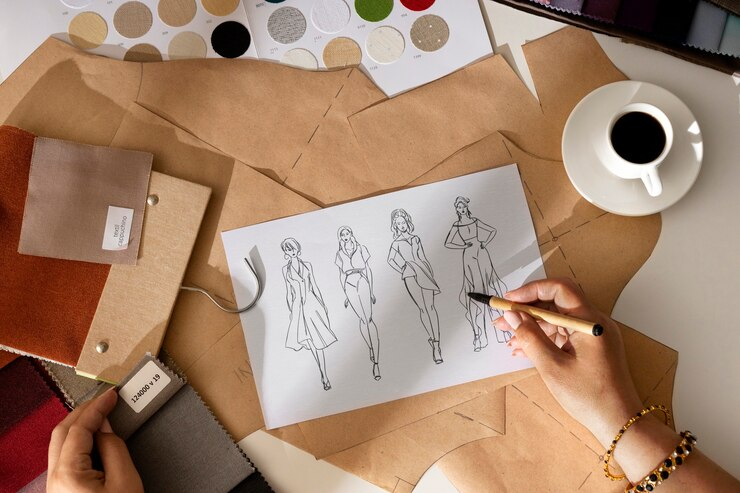
Underestimating Financial and Business Planning
Financial missteps can sink a clothing brand before it even gains traction. Skipping a detailed business plan leaves entrepreneurs unprepared for costs like sampling, production, shipping, and customs duties. Over-ordering inventory without sales projections often leads to unsold stock, tying up capital and storage space.
For example, a new brand might enthusiastically order 1,000 units of a single design, only to sell 200, leaving them with excess inventory and financial strain. To prevent this, create a costing sheet for each product, factoring in materials, labor, packaging, and hidden expenses like international shipping fees. Set realistic financial goals and use tools like pricing calculators to ensure profitability. A solid business plan acts as your roadmap, helping you navigate the complex economics of fashion.
Solution:
1. Create a Costing Sheet: Use a spreadsheet to list all expenses per product (e.g., $5 fabric, $10 labor, $2 packaging, $3 shipping). Add a 20% buffer for unexpected costs like customs fees.
2. Start with Minimum Order Quantities (MOQs): Work with manufacturers offering low MOQs (e.g., 50–100 units) to test demand. Platforms like Maker’s Row connect you with such suppliers. If you have requirements for customized suits, you can directly contact Kutetailor for tailored solutions.
3. Set Pricing with a Formula: Aim for a 2.5–3x markup on production costs (e.g., $20 cost = $50–60 retail) to cover overhead and profit.
Neglecting Market Research and Customer Needs
Launching without researching competitors, trends, or customer preferences is a recipe for failure. Understanding the market is crucial to creating products that resonate. Without this, you risk designing for an oversaturated niche or setting prices that don’t align with customer expectations. For instance, entering the crowded streetwear market with generic hoodies priced too high is unlikely to attract buyers.
Conduct thorough market research to identify gaps and opportunities. Analyze competitors’ strengths and weaknesses, monitor social media trends, and engage potential customers through surveys or focus groups. This data-driven approach ensures your designs meet real demand and stand out in the marketplace.
Solution:
1. Analyze Competitors: Pick three competitors and study their pricing, bestsellers, and customer reviews on platforms like Shopify or Amazon. Note what customers love (e.g., soft fabrics) or hate (e.g., slow shipping).
2. Track Trends: Use Google Trends to check search volume for keywords like “sustainable dresses” or “streetwear hoodies” over the past 12 months. Follow Instagram hashtags (e.g., #slowfashion) to spot emerging styles.
3. Validate with Customers: Create a Google Form survey with 5–10 questions (e.g., “What’s your budget for a jacket?”) and share it in relevant Reddit communities or Facebook groups. Aim for 50 responses to guide your designs.

Overlooking Effective Marketing Strategies
Many new designers assume that great products will sell themselves, but neglecting marketing is a critical error. Even the most innovative designs will languish without visibility. Random social media posts or poorly targeted ads rarely generate sales. For example, posting on Instagram without a cohesive strategy or influencer partnerships is unlikely to build a loyal following.
To avoid this, develop a marketing plan early. Focus on platforms where your audience is active, such as Instagram or TikTok, and leverage email campaigns to nurture leads. Collaborate with niche influencers or fashion bloggers to amplify your reach. Storytelling is key—share your brand’s journey, values, and creative process to connect emotionally with customers. A strategic marketing approach ensures your brand gets noticed in a crowded industry.
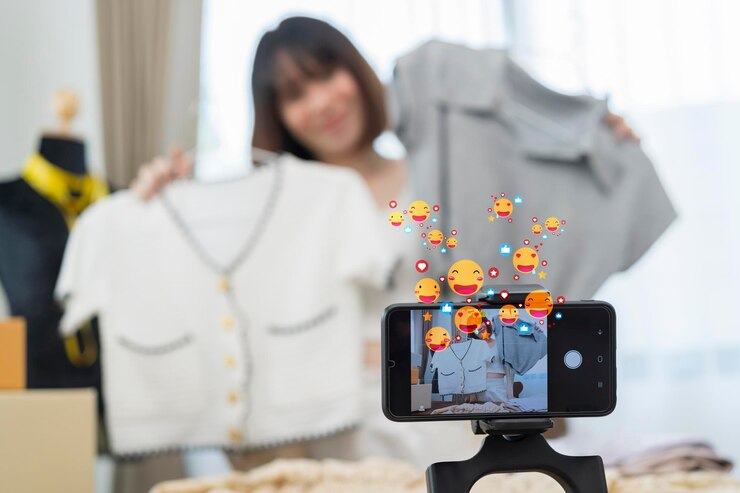
Choosing Incompatible Business Models or Partners
Selecting the wrong business model or partners can derail your brand. Thoroughly vetting manufacturers is key to avoiding issues like inconsistent sizing or late shipments. Cheap overseas factories often deliver subpar quality, damaging your reputation. For example, partnering with an unverified factory might result in garments that don’t match your mockups, leading to customer complaints.
Similarly, choosing a business model like bulk production without the capital or demand can lead to overstock and financial loss. Whether you are planning a custom formal wear line or launching casual basics, starting with a low-risk model like print-on-demand or small-batch production can help you test the market effectively.Research suppliers carefully, request samples, and prioritize clear communication to ensure quality and reliability. The right partners and model lay a strong foundation for growth.
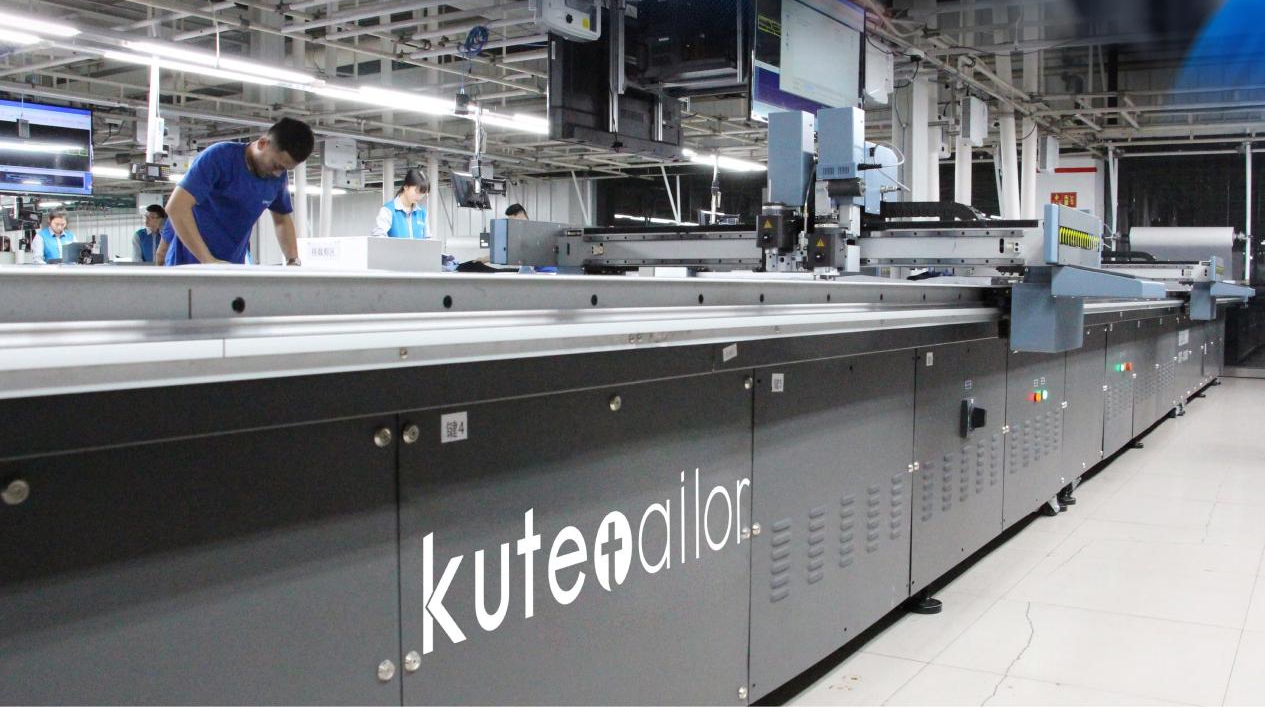
Kutetailor, a leading made-to-measure clothing manufacturer, offers a one-stop platform with advanced smart factory capabilities, premium fabric sourcing, and seamless API integration for tailored solutions. Kutetailor specializes not only in formal garments but also in custom women's clothing, offering premium fabrics, precision cutting, and extensive customization options to match your brand’s vision. Whether you need small-batch orders to test the market or larger runs for established demand, Kutetailor ensures precision and efficiency for your bespoke apparel needs, making it an ideal partner for brands prioritizing quality and flexibility.
Overcomplicating the Product Line or Launch
A common rookie mistake is launching with an overly ambitious product line. Designing too many SKUs (stock-keeping units) strains resources and confuses customers. For instance, releasing a 50-piece collection instead of a focused 5-piece capsule can lead to inventory issues and dilute your brand’s message.
For example, if you're starting with custom smart casual collections, it’s better to launch with a refined capsule that truly reflects your brand identity rather than an overwhelming product lineup.
Overinvesting in non-essential elements, like elaborate packaging or a complex website, also drains funds. To keep things manageable, start with a small, cohesive collection that showcases your brand’s core aesthetic. Use customer feedback and sales data to refine and expand your line over time. A lean, focused launch sets you up for sustainable growth.
Compromising on Quality and Customer Experience
Cutting corners on quality or customer service is a surefire way to harm your brand. Testing samples is essential to ensure fabric quality and sizing consistency. Neglecting customer experience, such as unclear return policies, erodes trust. For example, shipping garments with inaccurate sizing charts can lead to high return rates and negative reviews.
Invest in quality control by ordering and testing samples before production. Develop accurate sizing charts and communicate them clearly on your website. Implement a transparent, customer-friendly return policy to build trust. Prioritizing quality and service creates a positive experience that turns first-time buyers into loyal advocates.
Conclusion
Starting a clothing brand is an exhilarating journey, but success hinges on avoiding common pitfalls. By learning from these mistakes and adopting a strategic, customer-centric approach, you can navigate the competitive fashion landscape with confidence.
Take the time to craft a compelling brand story, plan your finances meticulously, research your market, and prioritize quality. With patience and persistence, your clothing brand can carve out a niche and thrive. Start small, stay focused, and let your creativity shine—your dream brand is within reach.
MORE 2025-04-30 -
 How to Create Your Perfect Custom Tuxedo in 6 Steps
How to Create Your Perfect Custom Tuxedo in 6 StepsLooking to make a lasting impression at your next big event with a tuxedo that’s tailored just for you? A custom tuxedo isn’t just custom formal wear—it’s a personalized masterpiece that boosts your confidence and reflects your unique style, perfect for occasions like weddings, galas, or proms.
Why You Can Trust This Guide
Customizing a tuxedo can be overwhelming—individuals often worry about fit and style mismatches, while designers face challenges like sourcing quality bulk orders with tight deadlines. I’ve been through these struggles and have helped hundreds of clients, from individuals to brands, create tuxedos that exceed expectations. My 6-step process has been refined over years to ensure a seamless experience, whether you’re tailoring a single piece or ordering in bulk. Follow this guide, and you’ll have a tuxedo that looks and feels amazing for your big moment—or your business. Here’s what you’ll learn:
· How to define your style and choose the right fabric for your occasion.
· How to customize details to make your tuxedo truly yours.
· How to ensure a perfect fit, whether you’re working with a local tailor or an online supplier.
Let’s get started on crafting your perfect custom tuxedo!
Step 1: Determine Your Style and Vision
Start by envisioning your ideal tuxedo:· Consider the Event: A black-tie wedding will likely call for a formal black tuxedo, while a prom will suit a darker navy or burgundy.
· Choose a Style: Explore types of tuxedos—opt for a timeless black tuxedo with satin lapels, a luxurious velvet jacket, or a modern midnight blue design.
· Think About Fit: Decide if you prefer a slim, tailored fit or a more relaxed, classic cut.
Research event dress code and browse online inspiration in order to further refine your idea.

Step 2: Choose the Proper Fabric and Color
Fabric and color define the foundation of your tuxedo's look and feel:· Select a Fabric: Wool is durable, functional; velvet offers luxury; and silk adds sophistication. For warm weather, select lightweight linen.
· Select a Color: Black is timeless, but navy blue or charcoal gray offers a modern twist. For a bold statement, try deep burgundy or forest green.
Match the color to your skin tone and the event’s formality. Heavier fabrics like wool suit cooler weather, while lighter ones like linen are ideal for summer.
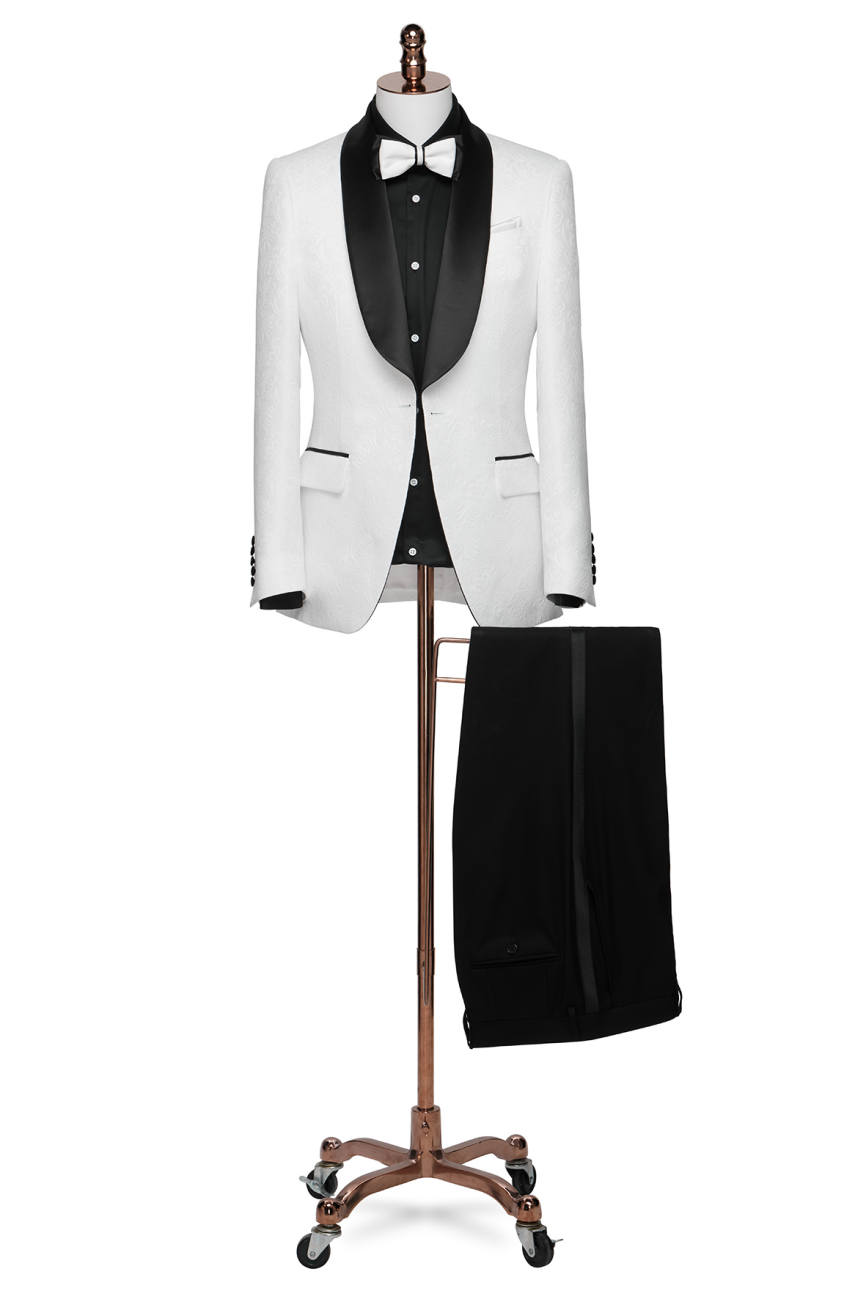
Step 3: Choose Lapel Style
The lapel style completes your tuxedo's overall look:· Notch Lapel: A traditional, all-purpose choice for formal events.
· Peak Lapel: Bold and pointed, ideal for making a strong statement.
· Shawl Lapel: Stylish and chic, great for black-tie events.
Common Mistake to Avoid: Don't choose a lapel design that overwhelms your figure—e.g., peak lapels on a very thin figure might look disproportioned.

Step 4: Customize the Details
Add personal touches to make your tuxedo truly yours:· Buttons: Choose satin-covered buttons for a traditional look or mother-of-pearl for a luxurious touch.
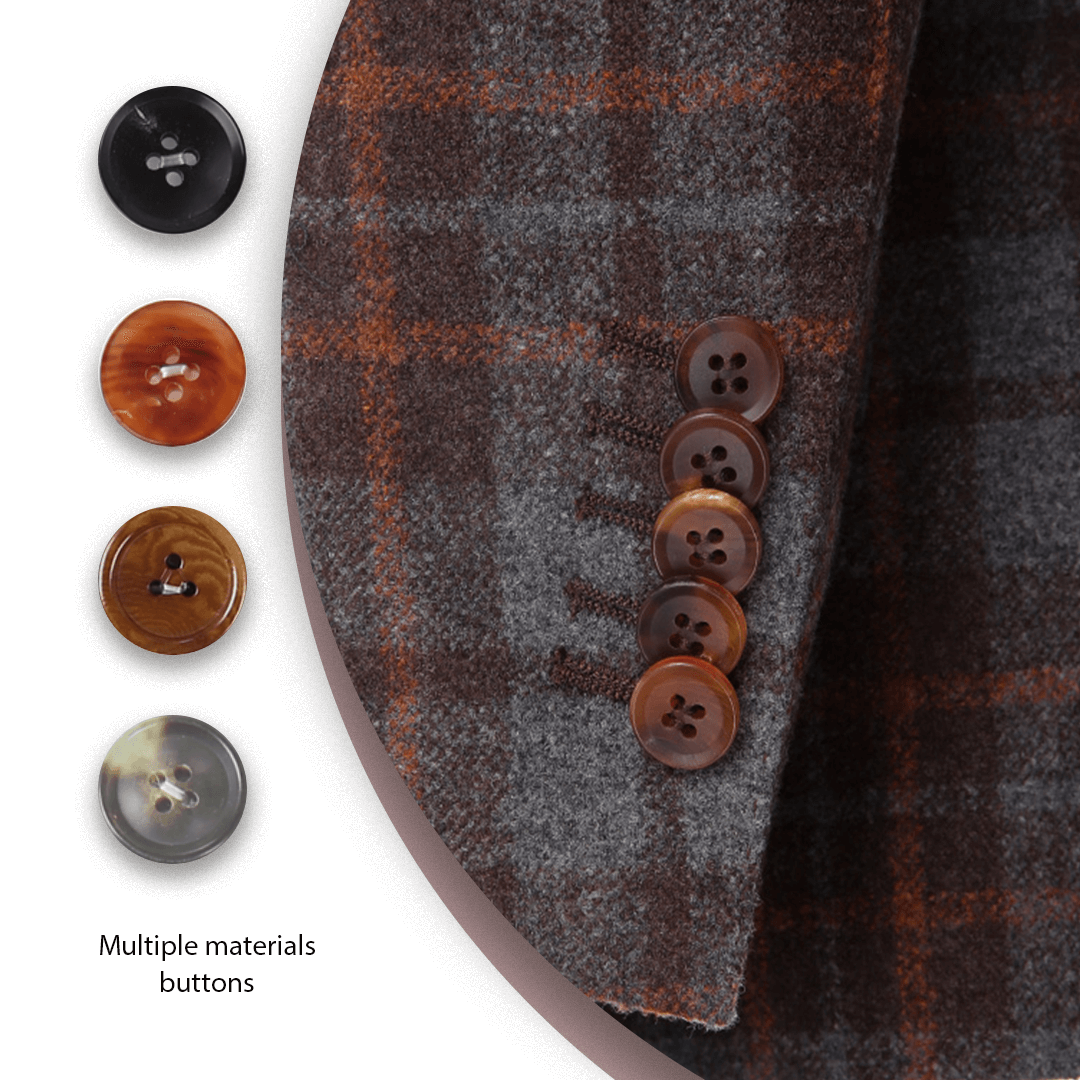
· Pockets: Jetted pockets keep it sleek, flap pockets add detail, and a ticket pocket offers a quirky flair.
· Linings: Select a lining that matches the fabric or go bold with a contrasting color or pattern for a fun surprise.
Ensure buttons complement the fabric, and pick a lining that enhances comfort and breathability.
Step 5: Get Measured and Review the Design
This step ensures your tuxedo fits perfectly, whether you’re an individual or a designer ordering in bulk:· Take Measurements: Visit a tailor for in-person measurements, or if ordering online, ask a family member or friend to help measure your chest, waist, inseam, and more. Designers bulk-ordering can use made to measure suits online platforms like Kutetailor to input sizes directly after selecting fabric and details online.
· Review the Design: Request a sketch or 3D preview from your tailor (for individuals) or use the supplier’s online 3D preview tool (for designers) to confirm the design matches your vision.
· Fitting Appointments:
o For Individuals (Local Tailor): Attend an initial fitting to check the fit. Ensure the jacket’s shoulders sit perfectly, sleeves show a bit of shirt cuff, and the jacket buttons without pulling. For trousers, the waist should be snug, the length should break just above your shoes, and the thighs should feel comfortable. Make sure to consider the Pant Break—the way your trouser hem meets your shoes—to achieve a clean, tailored finish. Double-check buttons, linings, and other details to ensure they meet your expectations.
o For Designers (Bulk Orders): Request a sample from the supplier to review quality. Check the same areas (jacket, trousers, details) and provide feedback for adjustments before full production.
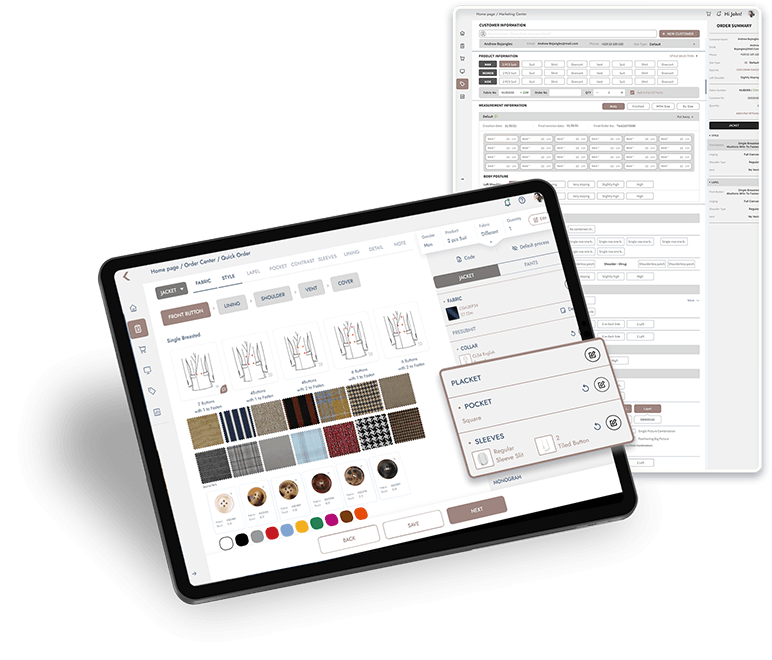
· Fitting Tips: For individuals, put on the shirt and shoes to be worn, note any discomfort, and walk around to test mobility and overall compatibility with accessories. Designers should also observe sample quality and design consistency, so the bulk order is as anticipated.
Step 6: Finalize and Take Delivery
Prepare for your event or production with these final steps:· Alteration Finishes: For individuals, your tailor will make adjustments post-fitting to perfect the fit. Designers will have adjustments applied to the bulk order after sample approval.
· Inspect the Tuxedo: For individuals, carefully check the stitching, buttons, linings, and pocket finishes to ensure top quality. Designers receiving bulk orders should verify consistency across all pieces, ensuring the entire batch meets quality standards.
· Plan for Delivery: For individuals using a local tailor, the time expected can range between 2-4 weeks, hence plan early. Designers who use sites like Kutetailor can expect delivery within as early as 7 business days without having a minimum order requirement, ideal for deadline tight projects.
· Prepare Your Look: Pair your tuxedo with accessories like a bow tie, cufflinks, and polished shoes to complete your ensemble.
Don’t skip the final inspection—small issues like loose buttons or uneven stitching can detract from your look or bulk order quality.
Final thoughts
Creating your perfect custom tuxedo in 6 steps ensures a garment that fits your style and body perfectly, whether you’re an individual preparing for a special event or a designer sourcing bulk orders. From defining your vision to final delivery, this process helps you—or your clients—shine with confidence and elegance. Now it’s time to take action and start your customization journey!Here’s how to take your custom tuxedo experience further:
· For Individuals: Use this guide to work with a local tailor and create a tuxedo that’s uniquely yours for your next big occasion.
· For Designers or Brands: If you’re a designer or brand looking to create unique designs or order custom tuxedos in bulk, Kutetailor offers a platform to streamline the process with suppliers. With fast delivery in as little as 7 business days and no minimum order quantity, it’s perfect for scaling your business. Visit www.kutetailor.com to discover how Kutetailor can support your tailoring needs.
· Stay Connected: Subscribe to our blog for more tailoring tips and style inspiration to elevate your wardrobe!
FAQ
What’s the difference between a tuxedo and a suit?
A tuxedo is designed for formal evening events, with satin lapels, a bow tie, and a polished look. Suits are more versatile, often lacking satin and used for business or casual settings. Our style quiz can help you pick the right one for your occasion.
How long does it take to get a custom tuxedo?
Most custom tuxedos are ready in 7-10 days with our platform, thanks to our streamlined made-to-measure process. For major events, order a few weeks early to allow time for fittings and any tweaks to ensure a perfect fit.
How much does a custom tuxedo cost?
Prices vary based on fabric and details, but our platform offers options for every budget, starting more affordably than you might think. Unlike rentals ($100-$200 per event), a custom tuxedo is a long-term investment. Check our site for a quick quote.
MORE 2025-04-19

